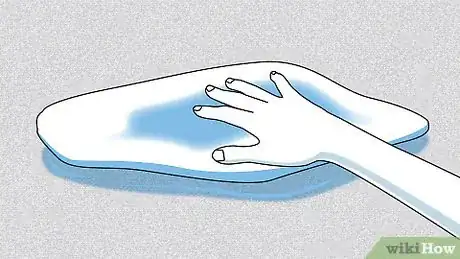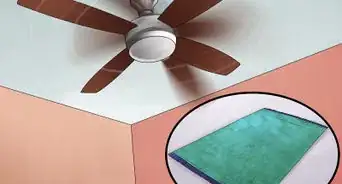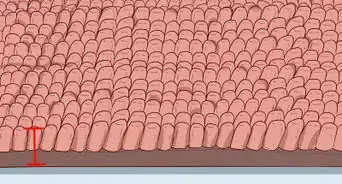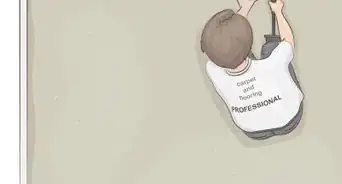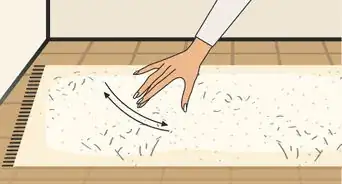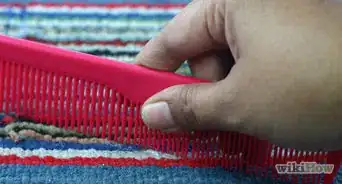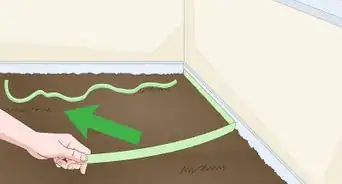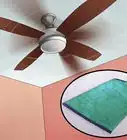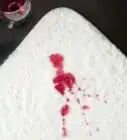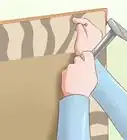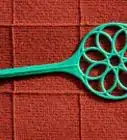This article was co-authored by Andrew Rohr. Andrew Rohr is a Carpet Cleaning Specialist and the President of MSS Cleaning out of Denver, Colorado. With over five years of cleaning experience, he specializes in carpet cleaning, stretching, and repairs as well as upholstery cleaning, water damage restoration, and tile and grout cleaning. Andrew holds a BA in Psychology and Business Administration from The University of New Hampshire and an MBA in Corporate Finance from The University of Denver.
There are 7 references cited in this article, which can be found at the bottom of the page.
wikiHow marks an article as reader-approved once it receives enough positive feedback. In this case, 100% of readers who voted found the article helpful, earning it our reader-approved status.
This article has been viewed 1,059,731 times.
If you have a small area rug or carpet that is wet, the best thing to do is remove it from the floor and hang or lay it outside until it dries completely. However, if you are dealing with wet wall-to-wall carpet, or a carpet piece that is too large to remove, you may need to try to dry it where it is.
Steps
Drying a Carpet Quickly
-
1Spread towels over the area of wet carpet. You'll then need to walk back and forth over the toweled area until the towels are completely saturated. Take those towels away and replace them with dry towels in the same area.
- Keep doing this until the area of the carpet is dry.
- You should still check underneath the carpet to make sure the carpet padding and the floor aren't sopping wet, as well.
-
2Vacuum the wet carpet. Do not do this with a regular home vacuum. You need a vacuum that is made to soak up water. Most vacuum cleaner sold for home use are for dry cleaning only and are extremely dangerous if used on wet carpets. Do not use your household vacuum cleaner unless it is approved for wet vacuuming.[1] [2]
- Vacuum the carpet with the wet vacuum cleaner until you get no more water. The wet vacuum cleaner removes water from the carpet itself, but it may not be able to remove it from the padding if the water has wicked through the carpet backing or soaked in under the edges.
- Keep an eye on the fill tank and make sure you dump it before hitting overflow. Depending on the amount of water in the carpet, you may have to dump the tank several times.
Advertisement -
3Encourage the moisture to evaporate. You should use this along with the other two options because it takes some time to achieve. Grab some ceiling fans, hairdryers, household fans, even a dehumidifier, if you have one.
- Keep them pointed towards the moisture until the water begins to dry up.
- Again, you'll need to check underneath the carpet to make sure that the floor and carpet padding are not still sopping wet.
- Try to create a "vortex" around the wet area. For example, you might take 3 fans and arrange them in a triangle around the wet area, all blowing outside of center instead of directly across the wet area. You could also rent air movers and professional dehumidifiers from a big box store.[3]
- If the weather is warm, open neighboring windows to allow the humidity to escape.[4]
Drying a Wall-to-Wall Carpet
-
1Move furniture off the wet carpet. You want to do this so that you can lift up the carpet and check the pad and the floor underneath. It's important to remove the furniture as quickly as possible so that you can get started on the carpet.
- Leaving the furniture on the wet carpeting can damage both the furniture and the flooring.
-
2Remove as much of the water as possible. You probably won't be able to take up the entire floor, but you are going to have to check beneath the carpet, so keep that in mind. There are several different ways that you can get rid of the water.[5]
- Rent a vacuum capable of removing water. Do not use a regular house vacuum, because a regular house vacuum can't handle vacuuming up water. Vacuum until you get no more water.
- Alternately you could rent a hot water extraction unit.[6] Check with a local carpet cleaning company to see if you can rent theirs. This helps suck the water from the carpet, although again you will have to check beneath the water.
-
3Check the amount of water beneath the carpet. Getting rid of the water on top of the carpet is only the beginning. You'll need to get rid of the water along the floor and in the padding beneath the carpet, otherwise, the floor could buckle.
- Walk across the carpet. If there's a sopping/squishing sound when you do, then there's definitely still water beneath the carpet.
-
4Raise carpet off the floor. Start in a corner. Using pliers and a pair of work gloves, start separating the carpet from the padding and the floor. You're going to need to dry the floor beneath the carpet, otherwise, it could cause floor buckling. Avoid cutting the carpet, because it will be incredibly difficult to put back together attractively.
- You can also lift the carpet up pulling it off of the installation strips at one of the corners. You can also do this on a carpet's side or edge if you have a short side that is easy to access and work with.
- Fold the corner or side of the rug over so you can see the carpet pad.
-
5Blow air between carpet and padding. You're going to want to try to dry the pad without removing the carpet, especially if the pad seems to have only gotten a little damp and the subfloor seems dry.
- A dehumidifier in a closed room will pull out water fast, and can be rented from rental companies.[7]
- Keep the corner or side of carpet that you have lifted raised and use a fan to blow air under the carpet unto the pad. Turn up the heat and open the windows to aid in the drying.
- Attach a vacuum hose (for vacuuming up wet things) to the exhaust of a vacuum then put the hose under the carpet, placing the carpet back over the hose. The hot air will cause the carpet to float over the pad and speed up the drying process.
-
6Call in the professionals. In the end, one of the best ways to deal with a wall-to-wall wet carpet is to call in someone who knows how to deal with it. It's important to do this as soon as possible so the company can salvage as much of the carpet, floor, and padding as possible.[8]
- Make sure the service is guaranteed and look for a company that promises to dry the carpet, the pad, and the floor if necessary.
- Check with your homeowners or renters insurance. Depending on the cause of the wet carpet, it is possible your policy may cover the cost of the carpet cleaning.
Drying a Carpet in the Car
-
1Don’t wait. Mold can grow within 24 hours and cause lots of problems. You'll need to dry the carpet in your car as quickly as possible. This will not only make sure that you avoid the mold, but it means that water won't get into electrical places that it shouldn't.[9]
-
2Determine where the leak is coming from. Only dealing with the carpets in your car without locating and stopping the leak isn't going to do you much good.[10] You'll have to keep on drying your carpets constantly.
-
3Remove as much water as possible. Use a shop vacuum that can remove water, or a dehumidifier (or both). These are easily rented. Use them to remove as much of the water as you can, especially from carpeting that can't be easily removed.
- Leave the dehumidifier in the car until the water seems to be gone.
- Make sure that you also sop up water with rags on the non-carpeted areas of the car.
-
4Check the padding under the carpeting. Water has a tendency to pool in the padding under the carpet. Not dealing with this can create mildew and mold problems. Always start by peeling up the carpet from a corner using pliers and work gloves.
- Avoid cutting the carpet as this will be incredibly difficult to fix later on.
-
5Remove all carpeting. It's really important that you remove the carpeting from the car, especially if the problem is an ongoing one. Peel it up carefully and put it somewhere that it can dry.
-
6Dry the carpeting separately. Once you've removed the carpeting from the car you have to work on drying it completely. You've already gotten the worst of the water out of it, but you need to make sure that it is completely dry otherwise mildew can form.
- Place towels over the carpeting and walk over them to get the water to soak up into the towels. Replace with fresh, dry towels as they get wet.
- Use a hairdryer and position it over the wet towels. Keep doing this until they are completely dry.
-
7Replace the carpets. Sometimes the absolute best thing you can do is replace the carpet, especially if you or anyone in your family is sensitive to mold. It doesn't take long for mold to grow and once it's there, it is very hard to get rid of.
- Discuss this with a professional before you do a complete overhaul of your car's carpeting because this is a drastic measure. Still, it is important to consider.
Expert Q&A
-
QuestionCan wet carpet be saved?
 Andrew RohrAndrew Rohr is a Carpet Cleaning Specialist and the President of MSS Cleaning out of Denver, Colorado. With over five years of cleaning experience, he specializes in carpet cleaning, stretching, and repairs as well as upholstery cleaning, water damage restoration, and tile and grout cleaning. Andrew holds a BA in Psychology and Business Administration from The University of New Hampshire and an MBA in Corporate Finance from The University of Denver.
Andrew RohrAndrew Rohr is a Carpet Cleaning Specialist and the President of MSS Cleaning out of Denver, Colorado. With over five years of cleaning experience, he specializes in carpet cleaning, stretching, and repairs as well as upholstery cleaning, water damage restoration, and tile and grout cleaning. Andrew holds a BA in Psychology and Business Administration from The University of New Hampshire and an MBA in Corporate Finance from The University of Denver.
Carpet Cleaning Specialist It depends. Anything that touches black water (sewage) likely needs to be thrown out. This includes carpet and padding. With clean water, the carpet can typically be saved, but the carpet pad may or may not make sense to save.
It depends. Anything that touches black water (sewage) likely needs to be thrown out. This includes carpet and padding. With clean water, the carpet can typically be saved, but the carpet pad may or may not make sense to save. -
QuestionWhat should I do if I can't lift up the carpet and can't get a water vacuum in order to suck up the water? What do I need to do to make sure it doesn't turn into mould?
 Community AnswerUse a cotton bed sheet to soak up all the water, then spread layers of newspaper over it. Try to press using a heavy object, done two or three times until most of the water is absorbed. Again cover it with newspaper and leave it overnight under a fan and it will dry soon. You can use a heater fan but only when you are present, to ensure that nothing goes wrong.
Community AnswerUse a cotton bed sheet to soak up all the water, then spread layers of newspaper over it. Try to press using a heavy object, done two or three times until most of the water is absorbed. Again cover it with newspaper and leave it overnight under a fan and it will dry soon. You can use a heater fan but only when you are present, to ensure that nothing goes wrong.
Warnings
- Whether you have to remove the carpet or not, the carpet and pad may shrink and seams may separate from the excess water. A professional carpet company should be able to do any needed repairs.⧼thumbs_response⧽
- If your carpet is wet with dirty water, remove it all as quickly as possible. Add more clean water to the wet carpet before vacuuming the dirty water out. Rent a carpet cleaner instead of just a vacuum and clean the carpet using carpet cleaner before vacuuming out excess water. Sucking out just the dirty water may cause the dirt to stay behind and stain the carpet.⧼thumbs_response⧽
References
- ↑ https://www.familyhandyman.com/basement/how-to-dry-out-basement-carpeting/
- ↑ Andrew Rohr. Carpet Cleaning Specialist. Expert Interview. 15 April 2021.
- ↑ Andrew Rohr. Carpet Cleaning Specialist. Expert Interview. 15 April 2021.
- ↑ Andrew Rohr. Carpet Cleaning Specialist. Expert Interview. 15 April 2021.
- ↑ http://www.floorpartners.com/blog/bid/33395/Floor-Help-My-Carpet-is-Flooded
- ↑ https://www.cleanlink.com/cleanlinkminute/details.aspx?id=50111
- ↑ https://www.ag.ndsu.edu/flood/media-resources/news-releases/after-the-flood/flood-damaged-carpets-rugs-may-be-saved
- ↑ Andrew Rohr. Carpet Cleaning Specialist. Expert Interview. 15 April 2021.
- ↑ http://community.cartalk.com/discussion/2286358/cleaning-soaking-carpets-in-car
About This Article
If you get your carpet wet, it’s important to act fast to keep it from getting moldy or musty. Start by laying some clean, dry towels down on top of the wet area. Walk back and forth over the towels or push on them with your hands to help them soak up as much water as possible. If the towels become soaked through, remove them and replace them with fresh ones. If you have a wet/dry vacuum cleaner, use that to pull as much of the remaining water out of the carpet as you can. Keep going over the area with the vacuum until you don’t see any more water going into the tank. If the carpet is really soaked, keep an eye on the tank and make sure to dump it before the water reaches the overflow line. Once you’ve gotten the carpet as dry as possible, encourage the rest of the moisture to evaporate as fast as possible by going over the carpet with a hair dryer or aiming one or more large fans at the wet area. If it’s a warm, dry day, open the windows to let air circulate through the room. You can also rent a dehumidifier or industrial fan from a big box store and put it in the room to help dry out the carpet faster. Don’t forget to check under the carpet to make sure the padding or underlayment underneath hasn’t gotten wet as well. If it has, you may need to replace it or temporarily remove the carpet to let it dry. If you’re dealing with a wall-to-wall carpet that has gotten completely soaked, your best bet may be to call in a carpet-cleaning professional. For tips on drying carpet in your car, read on!
